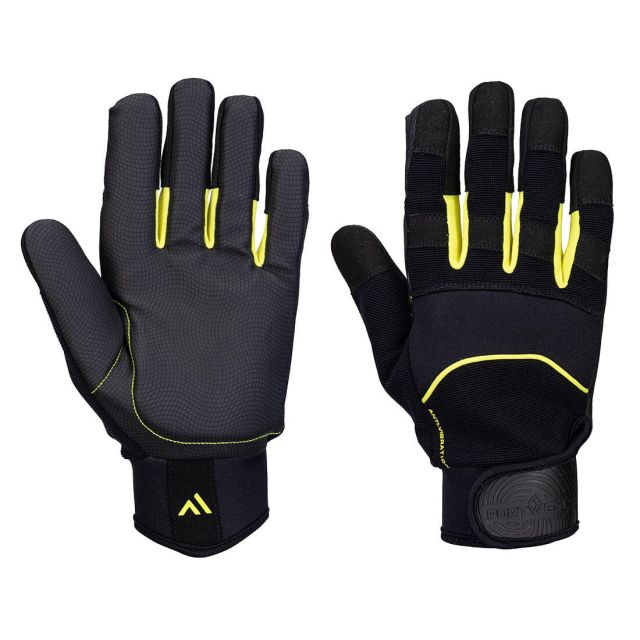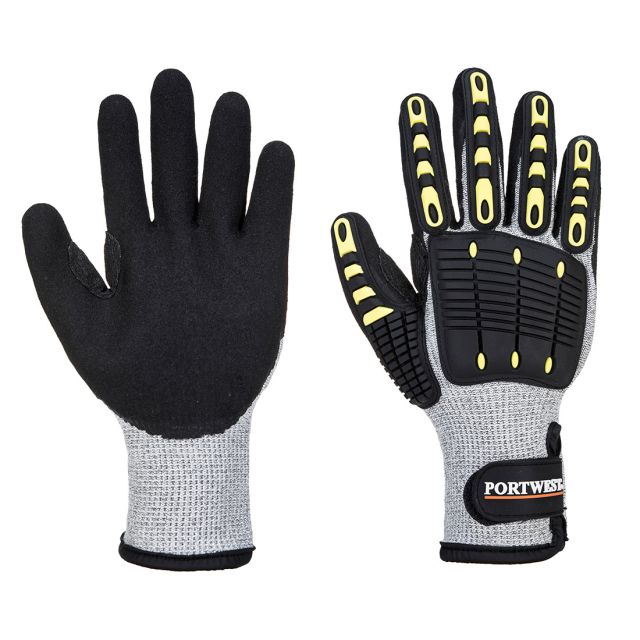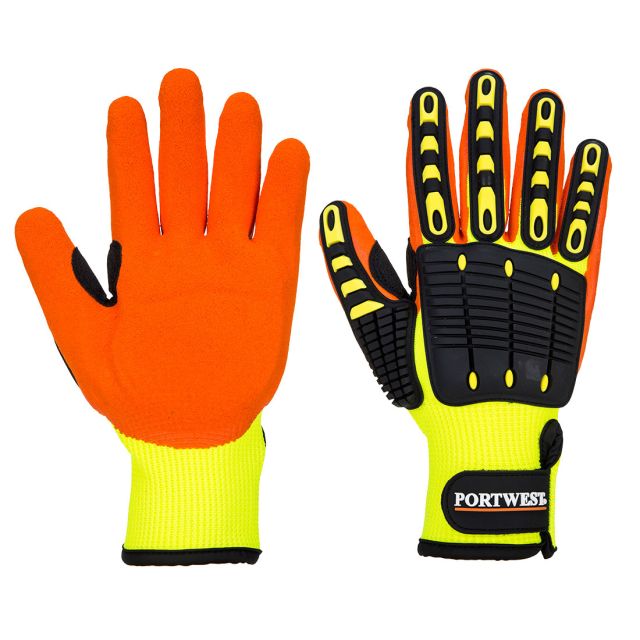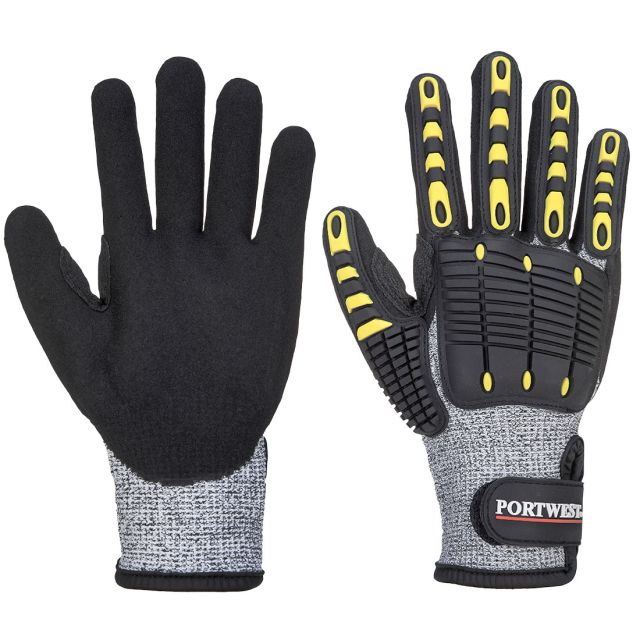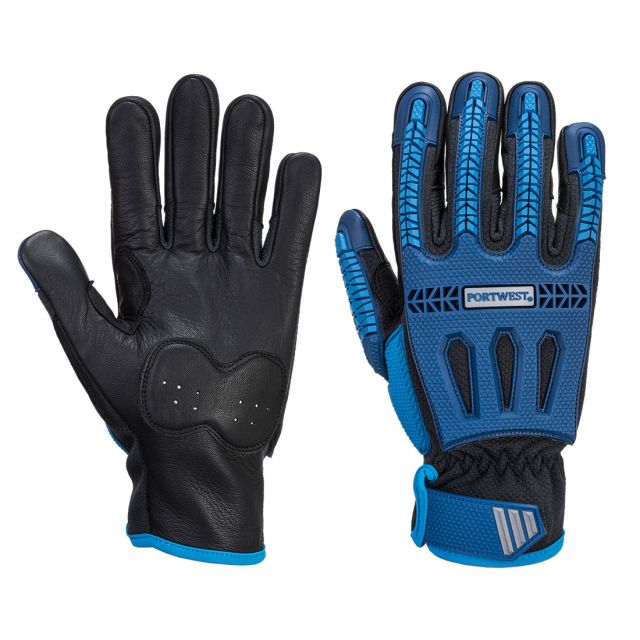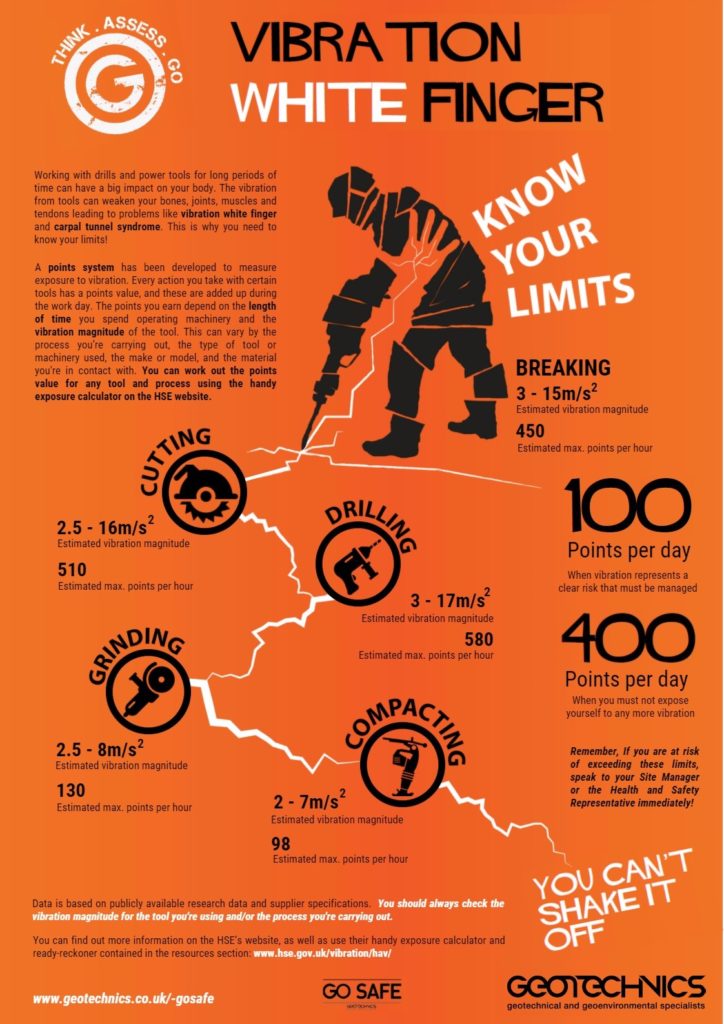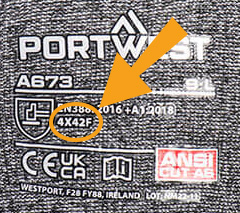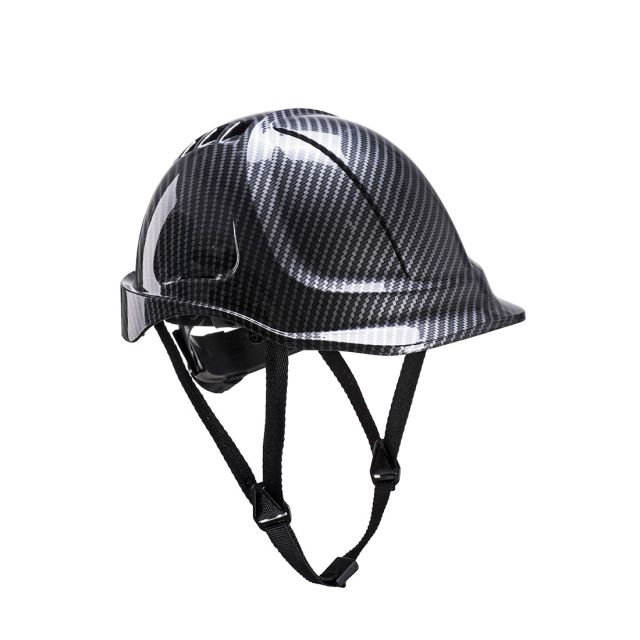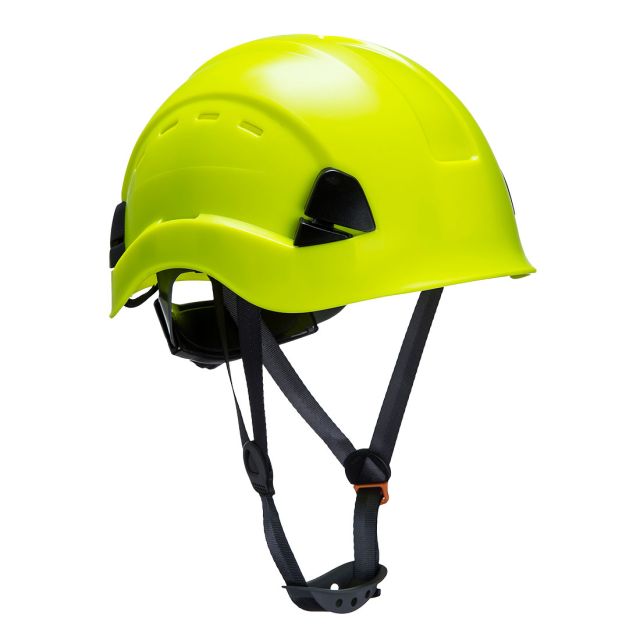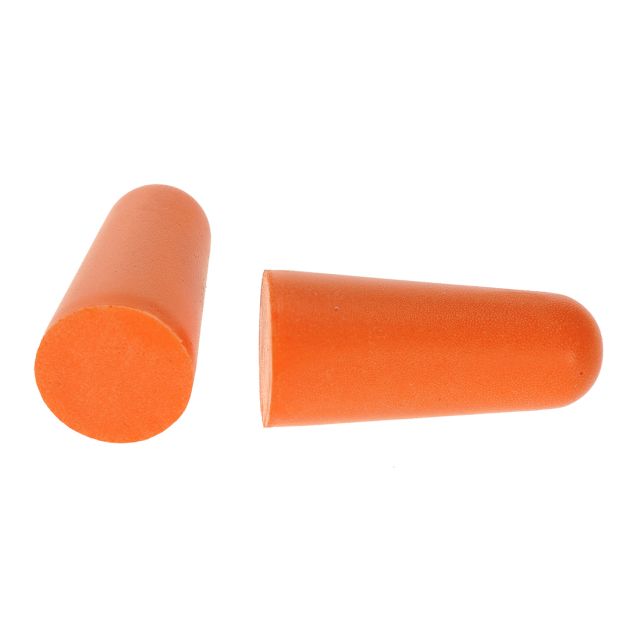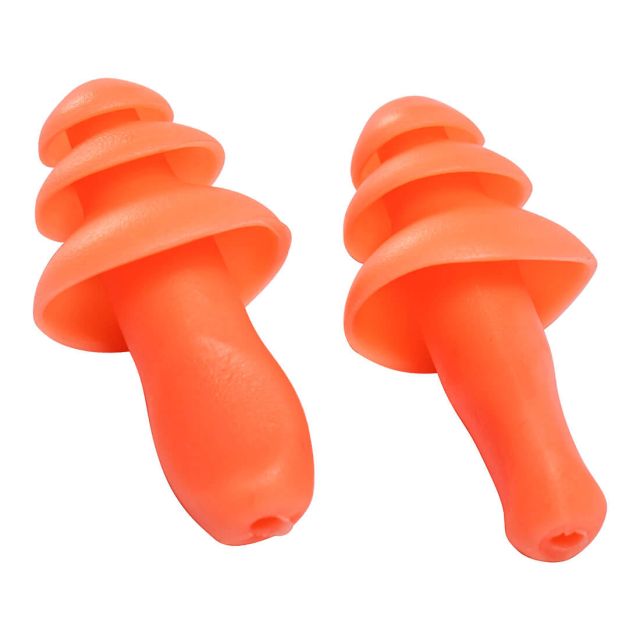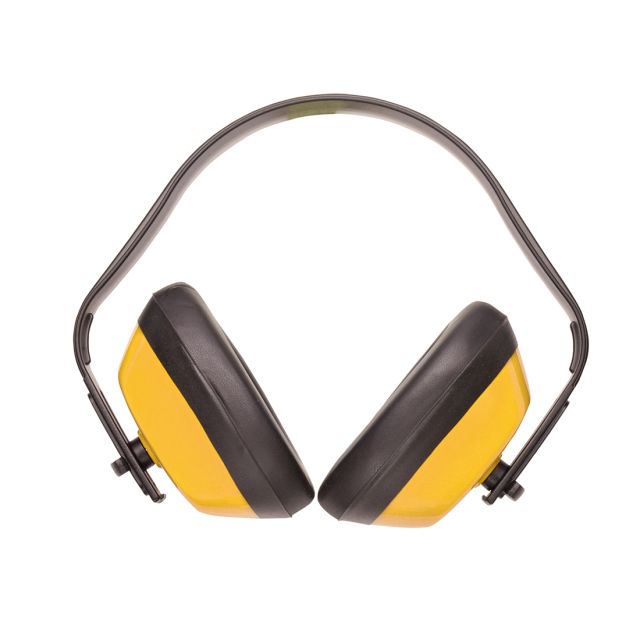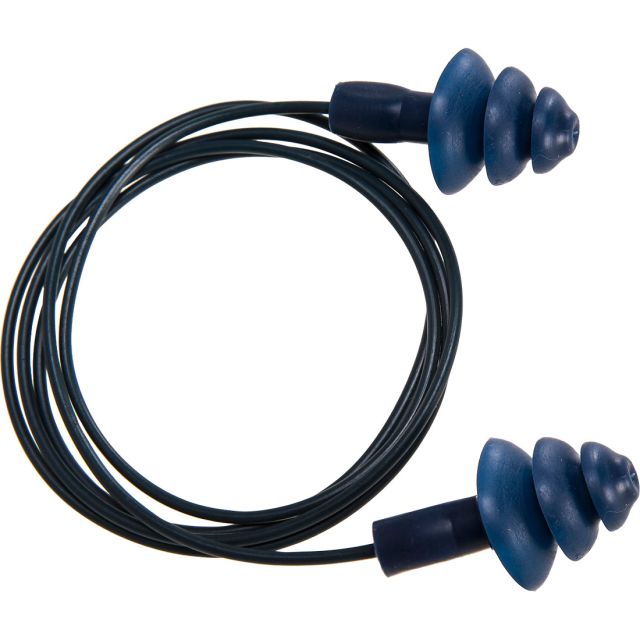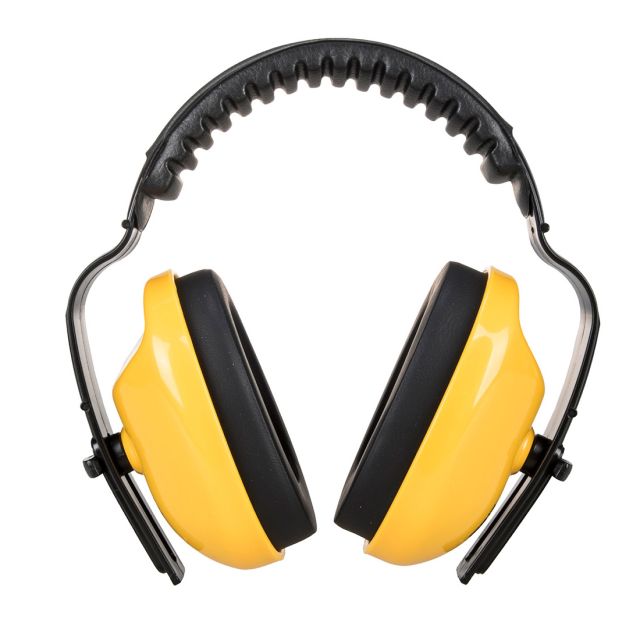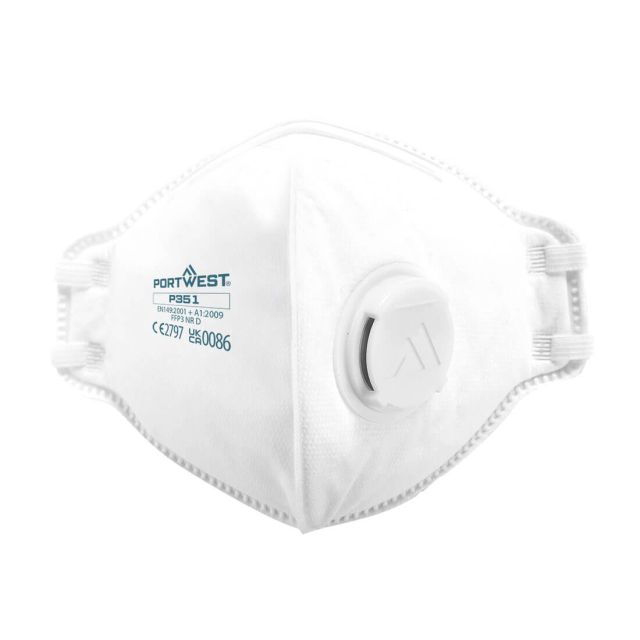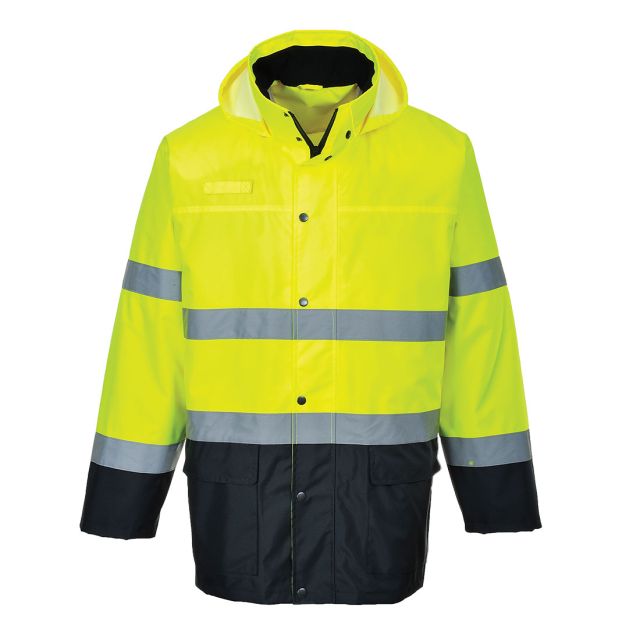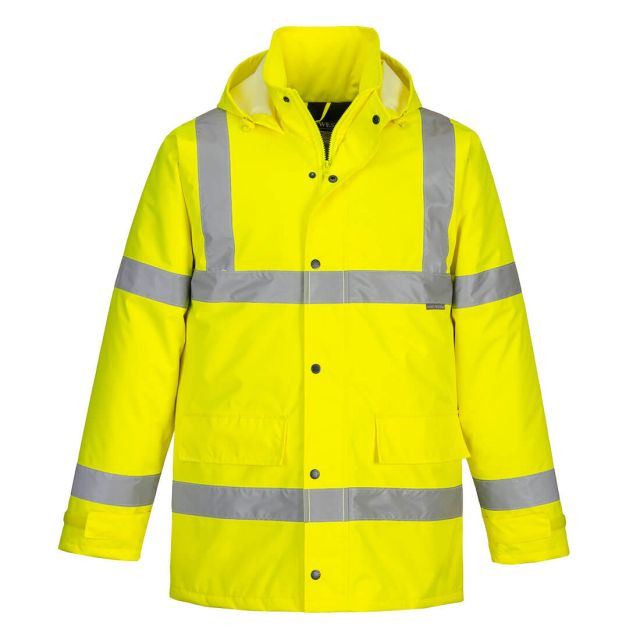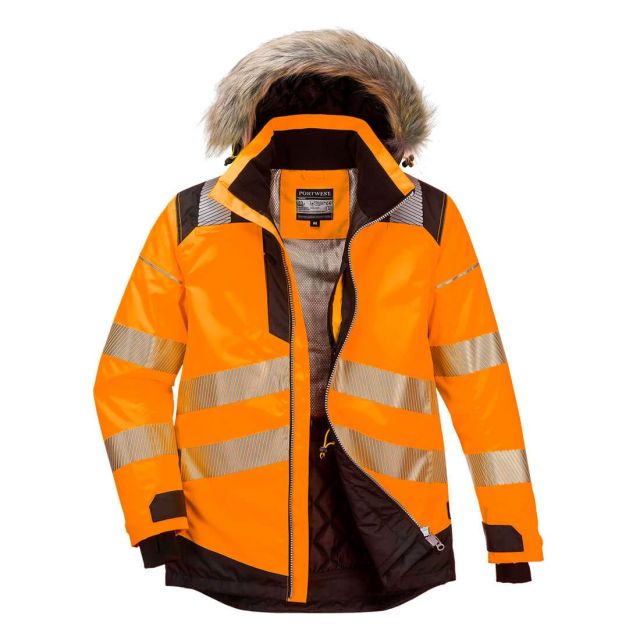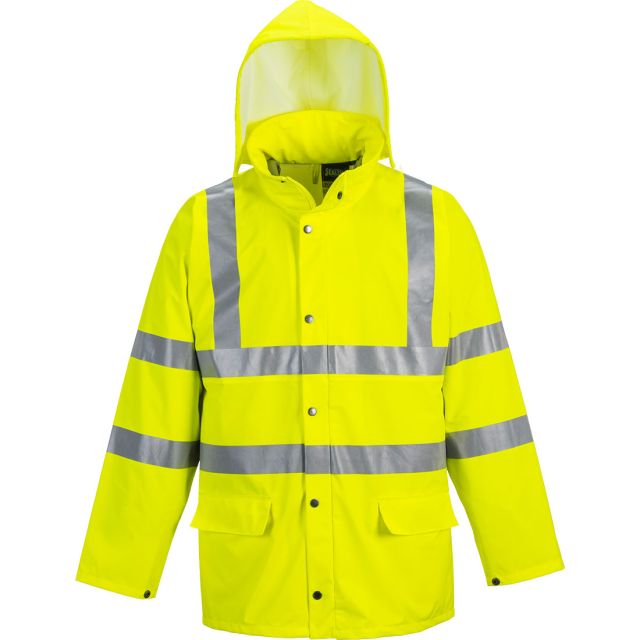The invention of Anti-vibration gloves were a gift from the PPE Gods for workers who use automatic equipment such as pneumatic tools, rivet guns, jackhammers, etc. As more and more tools became powered, there were more and more vibration injuries reported in the workplace.
Many brands offer different protection for the person who is wearing the gloves. These are vibration-dampening, impact resistance, and metacarpal protection, which all reduce the risk of injury.
Studies have shown that vibration resistant gloves reduce the risks of vibratory injuries but may not prevent other types of injury. It all depends on the glove.
- Page Contents
- The Risk of Injury
- Hand/Arm Vibration Syndrome
- Carpal Tunnel Syndrome
- Vibration White Finger
- Reducing Risks
- Do Anti-Vibration Gloves Work?
- Conclusion
The Risk of Injury From Vibration
Repeated vibration trauma is a serious health and safety problem for workers who operate heavy machinery without using the correct PPE such as anti-vibration gloves.
Those workers regularly exposed to vibrations from power tools are at risk of several injuries. These are Hand Arm Vibration Syndrome (HAVS), Carpal Tunnel Syndrome (CTS), and/or Vibration White Finger (VWF).
Hand/Arm Vibration Syndrome
(HAVS) is serious and disabling, with almost 2 million people at risk. Damage can include the inability to carry out fine motor work with the cold as a potential trigger for finger blanching attacks. Hand/Arm Vibration Syndrome can cause pain, tingling, and a loss of sensation or strength.
It is preventable with the correct type of anti-vibration gloves, but once the nerves, blood vessels, and/or joints are damaged, it is permanent.
Vibration White Finger
Vibration White Finger (VWF) is a form of Raynaud’s syndrome that is triggered by over-exposure and the use of hand-held machinery that vibrates. It affects 20% of the population worldwide. Although Vibration White Finger is the official term for this type of vibratory injury, it has been called "White Finger Syndrome" or simply "White Finger".
This syndrome causes the tips of your fingers to turn white because of abnormal spasms in the blood vessels that limit the supply to local tissues.
The primary disease is an autoimmune disease of the connective tissue, VWF is a secondary characteristic of the syndrome. Treat this by keeping warm, such as wearing gloves when it is cold. VWF can restrict blood supply, and in serious cases can cause ulcers, scarring, or gangrene.

The good news is that the number of cases of vibration related syndromes, are declining due to better awareness within the workplace. This has lead to regulations limiting the exposure of vibrations to workers, and of course, the introduction of cost-effective anti-vibratory PPE such as vibration dampening gloves.
Carpal Tunnel Syndrome
(CTS) is when the median nerve, controlling sensation and movement in the thumb and first three fingers, is pinched or compressed. This compression results in numbness, tingling, weakness, or pain in the hand.
Solutions to help ease the pain in your wrist from Carpal Tunnel Syndrome caused by vibration is to wear a wrist splint, relieving nerve pressure as you sleep. The best practice is to cut down on the causes, such as playing an instrument or using vibrating tools altogether - but anti-vibration PPE hand protection will reduce the risk before any problems occur.
How to Reduce Risks
For you and/or your employees, make sure that when you have to operate vibrating machinery, you keep your hands warm to improve blood flow and circulation. Take frequent breaks. Limit the time each person uses the equipment and invest in equipment that has reduced vibration.
Wearing protective gloves can help to keep your hands warm when it is cold. Because of this, it is always a good idea to wear them when using heavy, vibrating machinery. Although speciality gloves are not mandatory, they are needed to protect employees from the cold.
- Limit Time of Exposure to Vibration
- Keep Hands Warm During and Immediately After Exposure
- Take Frequent Breaks
- Wear Vibration Dampening Gloves
- Be Aware of the "Buzzing" in Your Hands & Fingers and ACT on any Changes
Do Anti-Vibration Gloves Work?
Anti-vibration gloves will protect the wearer because they keep hands warmer, improving blood flow as well as absorbing a great deal of the vibratory energy before it reaches the skin. Both are benefits when using vibrating machinery.
It is crucial to make sure you have healthy blood circulation to avoid any long-term health issues in your hands.
Although they are beneficial, the gloves should not be seen as a long-term solution for employees who use the machinery often. These PPE gloves do not reduce the frequency related to vibration injuries.
They offer many health and safety benefits, but the best way to protect employees from potential risks is to monitor how often they use the machinery. Also, you can provide other tasks for your workers to do so they can take a break.
Conclusion
Most Anti-vibration gloves do not protect the wearer completely from all hazards, although many now come with cut-resistance, but they offer a level of protection that is vital. As someone trying to build a PPE kit, invest in good quality, warm, well-fitting gloves to protect you from vibration related diseases.
But do anti-vibration gloves work to help prevent vibration related injury and diseases?
Absolutely
The invention of Anti-vibration gloves were a gift from the PPE Gods for workers who use automatic equipment such as pneumatic tools, rivet guns, jackhammers, etc. As more and more tools became powered, there were more and more vibration injuries reported in the workplace. Many brands offer different protection for the person who is wearing […]
In the realm of workplace health & safety, protecting workers' hands from cuts and lacerations is paramount. Cut resistant gloves stand as a frontline defence, offering vital protection to those working with sharp objects or in hazardous environments. Understanding the nuances of cut resistant glove ratings and levels, safety specifications, standards, and testing procedures associated with these gloves is crucial for ensuring compliant protection for workers.
In this cut protection glove guide you will learn all you need to ensure you and/or your employees are protected against cut hazards.
- Page Contents
- The EN 388 Safety Standard
- Cut Glove Specifications
- Materials & Fabrics
- Testing
- Applications
The Role of "EN 388 Protective Gloves against Mechanical Risks" Standard
Central to the regulation of cut resistant gloves in the United Kingdom is the EN 388 standard. This comprehensive standard lays down stringent requirements for testing and marking gloves designed for cut resistance.
EN 388 mandates that cut rated gloves undergo rigorous testing to assess their performance against mechanical risks. This includes cuts, abrasions, tears, and punctures.
There were updates to the gloves standards in 2016 and 2018. Testing procedures were changed to better simulate the real world and ensure accurate marking. It is now more properly known as the EN 388:2016+A1:2018 Protective Gloves against Mechanical Risks standard.
Understanding Cut Glove Safety Ratings
It's essential to decipher the markings on the gloves themselves when choosing the right cut resistant gloves. These specifications, indicate the gloves' resistance to cuts and lacerations.
The old markings
The old numerical scale ranged from 1 to 5, with higher numbers indicating greater levels of protection. For instance:
- Level 1: Provides basic protection, enduring one cutting cycle to full severance/penetration.
- Level 2: Offers moderate protection, withstanding two cutting cycles.
- Level 3: Provides substantial protection, resisting up to five cutting cycles.
- Level 4: Offers advanced protection, enduring ten cutting cycles.
- Level 5: Represents the highest level of protection, capable of withstanding 20 or more cutting cycles.
These standards are now deprecated. It is unlikely you will be supplied with new gloves carrying these coded ratings from a BSIF Registered Safety Supplier.
The new and much improved cut resistant glove standards
The EN 388:2016 standard introduced a significant update to the classification system for mechanical risks by introducing an additional cut scale from A to F. This expansion allowed for a more nuanced evaluation of a gloves' performance, particularly in terms of their resistance to cuts and abrasions.
Here's how a typical cut resistant glove marking will now look:
The example cut glove above is rated F.
See the 5 character code on the back of the glove? In that example it is 4X42F. The F is the cut resistance designation.
Here's a breakdown of the new cut rating system
- Abrasion Resistance: This parameter measures the glove's resistance to abrasion. Performance is rated on a scale from 0 to 4, where 4 indicates the highest level of resistance. The above glove is rated 4 for abrasion resistance.
- Blade Cut Resistance: Reflecting advancements in testing methodologies, this scale assesses the glove's ability to withstand cuts from sharp blades. The rating ranges from 0 to 5, with 5 indicating the highest level of protection against blade cuts. This is to the old scale, so may contain a number, or as in the example above, it could be an X to show it was not tested in the old scale.
- Tear Resistance: Evaluating the glove's resistance to tearing, this scale provides a rating from 0 to 4. The above glove is rated 4 for tear resistance.
- Puncture Resistance: This scale measures the glove's ability to resist punctures from sharp objects, with ratings ranging from 0 to 4. The above glove is rated 2 for puncture resistance.
- Cut Resistance in Accordance with ISO 13997: This scale provides an alternative method for assessing cut resistance, particularly for materials where the traditional Coupe Test may not be suitable. It rates gloves from A to F, with F indicating the highest level of cut resistance according to the ISO 13997 testing method.
The above glove is rated F for cut resistance, the highest level of protection.
This updated classification system offers a more comprehensive evaluation of a gloves performance across various mechanical risks. This provides users with valuable information to make informed decisions regarding hand protection in the workplace.
Cut resistant gloves are tested to a minimum performance level. If you are not sure of the required cut protection level you need, choose the next level up.
Find a more comprehensive guide to calculating your required cut level in our article: how to choose the correct cut glove level.
Materials and Fabrics
What are cut resistant gloves made of? Cut resistant gloves are manufactured from a diverse array of materials and fabrics, each chosen for its specific properties and performance attributes.
Manufacturers commonly use high-performance fibres like Kevlar®, Dyneema®, and Spectra® due to their exceptional strength, durability, and resistance to cuts and abrasions. Additionally, gloves may feature coatings of nitrile or stainless steel for enhanced protection and grip in various working conditions.
Glass fibre yarn offers a surprising tensile strength and alone offers up to level B resistance to cutting. Crushed Basalt rock can be woven into filaments that offer a higher cut resistance to glass.
Any of the above materials can be mixed and woven together to create a stronger fabric.
Testing Procedures for Compliance
Ensuring the effectiveness of cut resistant gloves necessitates rigourous testing procedures.
The EN 388 standard employs several testing methods to evaluate gloves' resistance to mechanical risks. The Coupe Test is used to assess abrasion resistance, while the ISO 13997 TDM-100 Test determines the force required to cut through the glove material.
The Coupe Test
The standard method for assessing the abrasion resistance of glove materials is the Coupe Test. This test subjects glove materials to repeated rubbing against a rotating abrasive surface. It provides valuable data on the durability and longevity of glove materials under simulated wear conditions.

The test is typically conducted using an abrasion machine equipped with a rotating drum or abrasive surface. Gloves to be tested are securely mounted onto holders or fixtures within the machine, ensuring consistent testing conditions.
The rotating drum or abrasive surface applies a constant rotational force to the surface of the glove material. As the glove material rubs against the abrasive surface, frictional forces are generated, simulating wear and tear over time.
Gloves are visually inspected for signs of wear after testing, looking for problems such as surface abrasion, loss of material, or visible damage. The results of the Coupe Test provide a quantitative measure of the glove's abrasion resistance, typically reported as the number of cycles completed before a specified endpoint is reached. A higher number of cycles indicates greater abrasion resistance and durability.
ISO 13997 TDM-100 Test
The ISO 13997 TDM-100 test evaluates the resistance of glove materials to cuts and slashes by measuring the force required to penetrate through them with a rotating blade. It provides a quantitative measure of a glove's ability to withstand sharp object penetration, aiding in determining its level of cut resistance.

A TDM-100 machine which was specifically designed for this purpose, is typically used to conduct this test. The machine consists of a test fixture, a blade holder, and a cutting blade. To ensure consistent testing conditions, glove samples are securely mounted onto the test fixture.
A blade with a specified geometry and sharpness is attached to the machine and driven into the glove material at a controlled speed and force. As the blade penetrates the glove material, shearing forces are generated, simulating the action of a sharp object slicing through the material.
The ISO 13997 TDM-100 test employs standardised blades with defined geometry and cutting edges to ensure consistency and reproducibility of test results. The blade typically has a straight edge and is made of a hard material such as steel or tungsten carbide.
After testing, the glove samples are inspected for cuts, slashes, or penetrations. The test results are recorded and used to determine the glove's cut resistance rating.
The force required to cut through the material is typically reported in Newtons (N) or grams (g). A higher force value indicates greater cut resistance and protection.
Tear Resistance Test
This evaluates the glove's ability to resist tearing, providing insights into its durability under stress. Tear resistance testing evaluates a glove's ability to resist tearing or ripping when subjected to external forces.
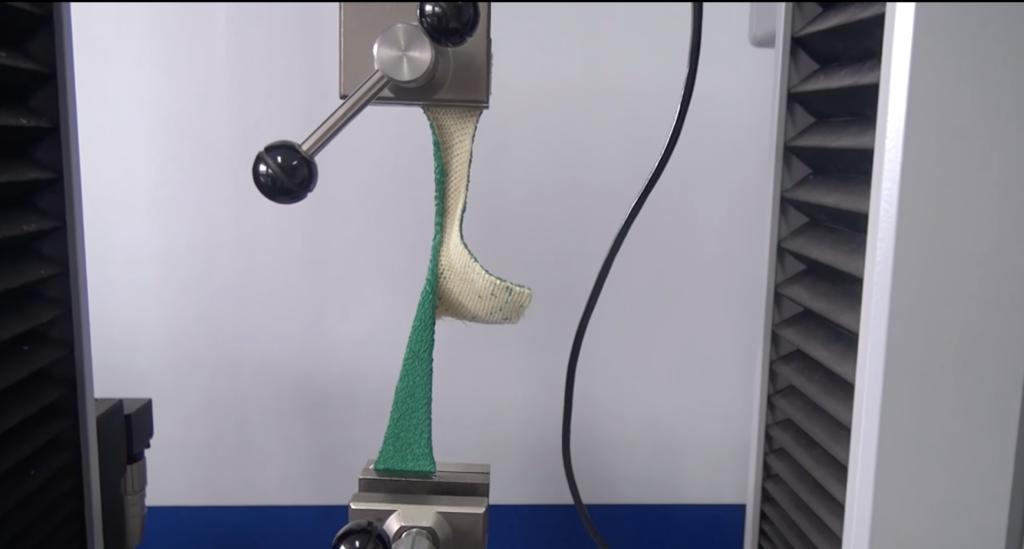
Glove samples are securely clamped between grips or jaws attached to the testing machine, ensuring uniform distribution of force during testing. This machine applies controlled tensile forces to the glove material, pulling it apart to induce tearing.
A higher tear resistance value indicates greater resistance to tearing or ripping, which translates to better performance and protection in real-world applications.
Puncture Resistance Test
Assessing the glove's resistance to punctures from sharp objects, this test helps determine its suitability for environments with piercing hazards.
The fabric is stretched taught between 2 discs to clamp it in place. A standardised puncture probe is driven into the glove material with controlled force and velocity to test the puncture resistance. The force required to puncture the glove is measured, providing a quantitative assessment of its puncture resistance.

Puncture resistance testing helps ensure that gloves offer adequate protection against sharp hazards, reducing the risk of injuries such as puncture wounds and needle sticks. It is particularly important in industries such as healthcare, waste management, and recycling, where workers are exposed to sharp objects as part of their job duties.
Applications Across Industries
Cut resistant gloves find applications across a myriad of industries where workers encounter sharp objects and machinery. From manufacturing and construction to automotive and metalworking, these gloves are indispensable for safeguarding hands against potential injuries.
Professionals in the food processing, glass manufacturing, recycling, and healthcare sectors rely on cut resistant gloves to mitigate risks and uphold safety standards in their respective fields.
In conclusion, the selection and utilisation of cut resistant gloves are critical components of workplace safety strategies.
By understanding the intricacies of safety specifications, materials, testing procedures, and applicable industries, employers can make informed decisions to protect their workforce from potential injuries. Investing in high-quality cut resistant gloves not only fosters a safer work environment but also underscores the organisation's commitment to prioritising employee well-being.
Remember, proactive measures today can prevent accidents and injuries tomorrow.
In the realm of workplace health & safety, protecting workers’ hands from cuts and lacerations is paramount. Cut resistant gloves stand as a frontline defence, offering vital protection to those working with sharp objects or in hazardous environments. Understanding the nuances of cut resistant glove ratings and levels, safety specifications, standards, and testing procedures associated […]
Construction workers, landscapers, forestry workers, warehouse operatives, engineers and even road-workers need different types of gloves due to the safety elements featured in each one. This is especially important for rig workers as the work onboard requires a number of areas to be covered.
It is possible that rigger gloves are not the best option for you or your staff, so here is what you need to know before buying rigger gloves.
What are Rigger Gloves?
Rigger gloves are a type of work glove, usually reinforced with a leather palm and a backing of fabric with a leather strap to protect the knuckles.
Originally designed for oil rig workers (hence the name riggers), just like rigger boots, they are loose fitting in order to be easily removable in case of emergency and an essential part of a Rigger's workwear.
But don't let the name fool you, a rigger's glove is a handy item to have to hand!
Most riggers come in a one size fits all sizing and although they are designed for rigging and cable pulling, they are suited for a number of different working tasks.
Often considered a "General Handling Glove" you will find a pair of riggers on a variety of different work sites as they are designed with strenuous, heavy-duty work in mind and made for continued use and heavy-duty work.
Comfortable and Breathable Gloves
An important aspect of glove comfort is breathability. The last thing you need is to be constantly having to take your gloves off so your hands can escape the heat.
That is why features such as a cotton backing which improves breathability and ventilation to provide cool air through to the hands. This allows workers to remain comfortable without needing to continue taking their gloves off.
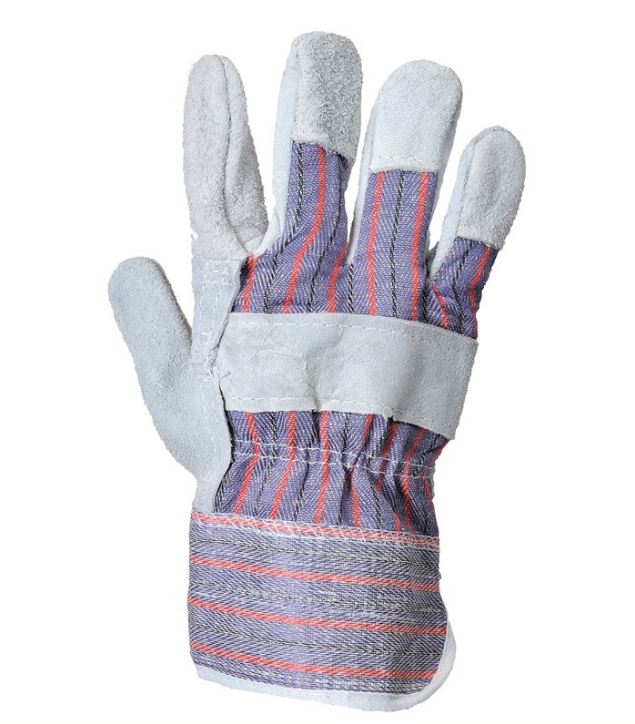
Rigger Gloves Bulk Buy: the more you buy the more you save!
Durable and Long-lasting Gloves
This is what separates the most work gloves from the rigger options.
Most work gloves are not designed to be continually used in construction, heavy lifting or even agricultural types of work. Eventually, the condition of the gloves worsen and they stop providing the necessary safety elements required to keep your hands safe.
That is why durability is a feature you need to consider before selecting a Rigger glove for work tasks. It is also more cost-effective.
The type and quality of leather the gloves features is an important aspect of the durability. The poorer the quality, the less durable they will be.
Instead, source rigger gloves which are made with premium quality leather to give them a prolonged life, even when you use them in strenuous tasks on a daily basis.

These Leather Rigger Gloves are exceptionally high quality for a very low price
Hand, Finger and Knuckle Protection
The most important feature of all hand protection is the level of protection the glove gives the wearer. Although seeing 'protection' labelled alongside the gloves is a good starting point, you should look for gloves that have more advanced safety features such as reinforced patches for protecting veins or knuckles and forefingers.
Hands can be in danger in any area and when they least expect it. By looking out for these safety features, you're ensuring that your workers wear the safest gloves possible.

Our customers say these are the best rigger gloves they have used
Palm Protection
For some tasks, more protection is required on the palm of the hand, thumb and forefinger than anywhere else. A Doubled layered palm rigger would be ideal for scenarios where there is more handling of unfinished metals or timbers.

These are considered Heavy Duty Rigger Gloves
Good Grip and Fit
The gloves you select can have all of the other features mentioned, but they might be considered useless if they have poor grip or if they fit your hands poorly. A proper fit and a safe grip are essential, particularly for heavy lifting, handling unfinished metals and in the construction industry.
Poorly fitting gloves can restrict movement resulting in muscle aches, blisters and cramps which can rule you out of more work, or at the least degrade your working conditions.
Look for seams across the palm and across the back of the glove as they are usually more comfortable and provide a more exact fit.
To ensure the gloves fit perfectly and are not at risk of falling off or slipping while you work, consider looking out for gloves that have a hook and loop fastening on the wrist band.
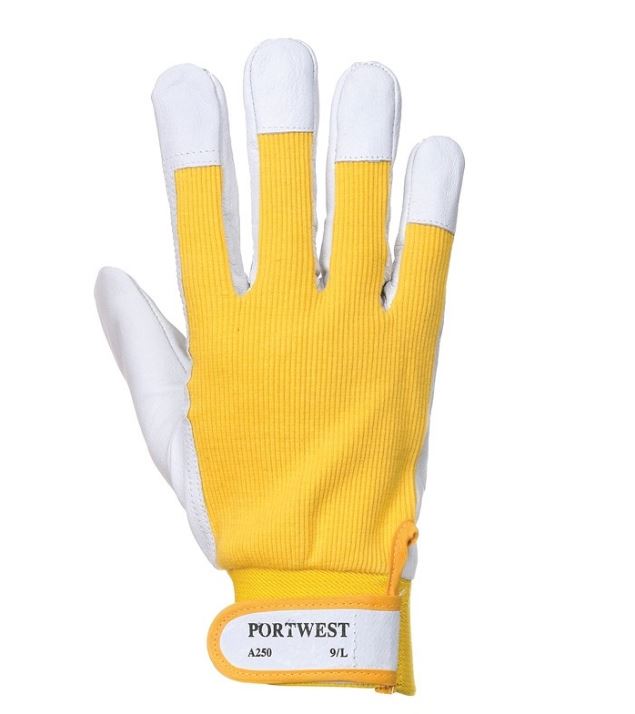
These may be a good alternative if you are looking for Waterproof Rigger Gloves... which don't exist.
Insulated Rigger Gloves
Finally, gloves which are insulated are a must for when you are working in the unpredictable British weather. As highlighted in the first point, gloves that are comfortable and breathable are needed - so ventilation is a good feature to look out for. However, in those colder conditions, they might not be the best choice to wear as hands can get cold making it more difficult to work comfortable, efficiently and safely.
Whenever you are working in cold environments, you should work with gloves that are insulated and even feature fleece lining for added warmth.
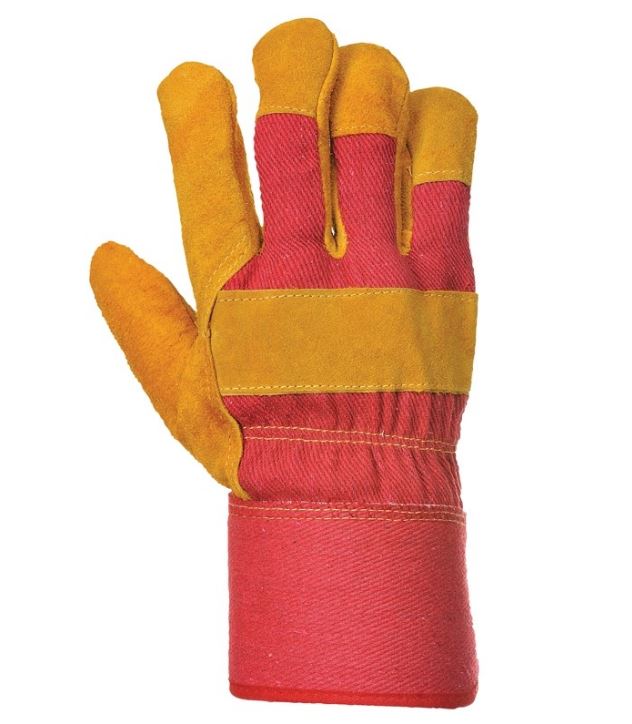
These are a fantastic alternative to Wool Lined Rigger Gloves, which can shrink when wet
Before You Buy Rigger Gloves
By checking for all of these features, you'll be in a much better position when it comes time to purchase the right type of rigger gloves for the task at hand.
Safety should not be an afterthought, so taking everything above into consideration, make sure that you do need Rigger Gloves and not a more specialist form of hand protection for your work tasks.
Construction workers, landscapers, forestry workers, warehouse operatives, engineers and even road-workers need different types of gloves due to the safety elements featured in each one. This is especially important for rig workers as the work onboard requires a number of areas to be covered. It is possible that rigger gloves are not the best option […]
Hand safety in the workplace is one of the most important aspects of Health & Safety. 40% of workplace accidents involve a worker's hands and 70% of hand injuries occur because the worker has removed their safety gloves.
Staggering, isn't it!?
Keeping your workforce's hands safe is everyone's responsibility, and it can make a huge difference to your workplace safety stats. Hand safety at work doesn't need to be a chore. With just 3 steps you can create a hand protection programme that works.
- 3 steps to safer hands
- Step 1: Understand the problem
- Step 2: Take Action
- Step 3: Make Continuous Checks
Step 1: UNDERSTAND the problem with hand safety
The first step involves gathering all the information about the accidents, near misses and injuries that occurred in your workplace, and filter all accidents involving the hands.
You might find this data in your accident book, or you might already have it stored digitally. Breaking it down into a simple spreadsheet really helps understand what is going on. Add columns for date, type of injury (cut, burn, crush, fracture etc), location, tools being used, environmental factors (was there Ice, Rain or Blazing Sun) and employee ID.
If you have a Health and Safety department or H&S consultant, they should really be doing this anyway. If not, it is likely down to you.
With this data, you will be able to answer these questions:
- What are the most common hand injuries?
- How did the injuries happen? (Can you put it down to handling tools, chemical exposure, an individual?)
- In what environmental conditions did injuries occur?
- Where are hand injuries happening
By doing this, you will get a good and quick idea of where there are Health & Safety issues at play. You will gain an understanding of the exact types of injuries happening to workers, where they are happening and what jobs are most risky.
With this data you should be able to nail down the specific hazards to hands, what practices are most likely to result in an accident and find any PPE requirements that may need changing.
Workers should always be supplied with gloves and PPE that provide adequate levels of cut protection, abrasion resistance, vibration resistance or whatever they need. Should hand protection practices be failing, you should investigate further to try and eliminate as much risk as possible.
XAMAX® offer free advice in hand protection to our customers - perhaps give us a ring if you're unsure what you need.
Step 2: TAKE ACTION to mitigate risk as far as practicable
Now you need to shift your focus onto doing something about what you've learned. Focus on training the workforce in the standards of safe handling and hand protection and include any new information you have gathered from step 1. Explaining why you are implementing new changes, or enforcing standards will help you get your points across.
You should make sure your instructions are clear on implementing your safety programme. Include:
- Which safety gloves should be worn for which jobs and why
- Correct use and care of safety gloves
- What checks will be in place to ensure compliance
- Any procedures for tracking PPE usage
Make sure everyone uses the correct protection for the job at hand and that everyone understands they have a responsibility to work safely.
A good way of reinforcing the training is with an awareness campaign internally. Posters, flyers and inclusion in the company newsletter will help your hand safety messages drive home.
Ensure some discussion is included in your team meetings and soon workers will be discussing it between themselves. Every little reminder helps drive down your incident rate.
Step 3: CHECK your new plan is working and that everyone is buying into their own hand safety
By step 3 you should have a change in safety culture, especially around workers protecting their hands. Everyone should be adhering to the safety guidelines. It is now time to monitor results.
Perform regular safety audits for hand protection PPE and keep records of your findings.
Create a checklist of requirements for each job to be completed before the work starts.
Provide simple means of reporting hazards for workers to report concerns. This gives the workforce ownership over their own safety.
Ensure line-managers help reinforce the need for hand protection.
However you do it, your objective is to ensure everyone involved has a full understanding of the need for hand protection, ensure they understand the procedures and ensure they understand they are for the safety of everyone.
You're done, but it never ends.
Taking these 3 steps as a basic starting point towards improving your workforce's hand safety, you should start to see injuries and incident rates fall. To know that, you will need to make regular records and compare them, probably monthly.
With luck, your rates will continue downward, but if you see a spike you will be able to act much faster than if you didn't measure.
Hand safety in the workplace is one of the most important aspects of Health & Safety. 40% of workplace accidents involve a worker’s hands and 70% of hand injuries occur because the worker has removed their safety gloves. Staggering, isn’t it!? Keeping your workforce’s hands safe is everyone’s responsibility, and it can make a huge […]
In 2016, new cut resistance ratings for anti-cut gloves and sleeves in the EN388:2016 standards were announced, and in 2019 these standards began to find their way into PPE product. You will likely be familiar with Cut 1 - 5 resistance levels, but these are now deprecated. The EN388:2016 cut proofing levels now range from Cut A to Cut F, with F being the highest cut protection available.
- Page Contents
- Old v New Standards
- Consider the Task
- Consider the Hazard
- Consider the Risk
- How to Work Out the Cut Resistance Level You Need
- Where to Buy Cut-Resistant Gloves and Sleeves
How Do The Old Cut Resistance Levels Correlate With The New Standards?
Simple answer: They don't.
There is no direct correlation between the old 1-5 standards and the new A-F standards, so you should learn how to find the right glove cut protection level for your work hazards.
It is quite easy to figure this out - you can work out the correct cut protection level for gloves or cut sleeves with just 3 simple steps of identifying the Task, the Hazard and the Risk of injury, and doing some very simple maths.
Having said that, Cut Protection Safety Gloves manufacturer Tilsatec has provided us with this generalised comparison table:
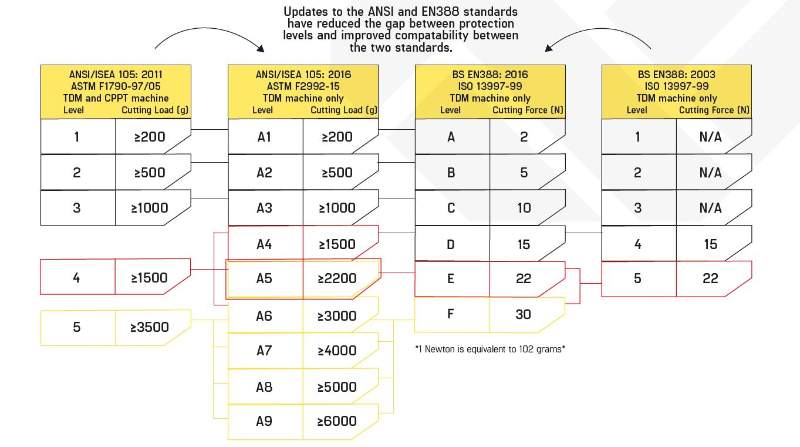
Task - What Job Are You Doing?
Identify the work you are doing, how much dexterity is needed and where you are working.
Assess the type of work that is being done and decide how much dexterity/flexibility is needed. Review the conditions of the working environment.
Type of work
- Light duty: low wear and a relatively clean environment. High gauge material can be considered with palm coating
- Medium duty: variety of working conditions but still low wear
- Heavy duty: high wear, tough working conditions, dirty environment
Required Dexterity – Gloves Material
- Low: handling large bulky items – Leather Gloves, PVC. 7-gauge fabric
- Medium: handling smaller items that can be held in one hand – Polyester, Aramid. 10-gauge fabric
- High: handling very small items that can be held in the fingertips – Nylon, HPPE. 13 – 18-gauge fabric
There are a variety of different materials used to make gloves. Here are some examples of materials used as coatings by cut glove manufacturer Portwest for different working applications.
| Working Conditions | Coatings |
| Dry | PU, Latex, Nitrile (Foam, Sandy, Smooth) |
| Wet | Latex, PU, Nitrile (Foam, Sandy) |
| Oil & Grease | Nitrile (Foam, Sandy) |
| Chemical | Latex, Nitrile, PVC |
| Heat | Leather |
| Cold | All |
There are an infinite combination of tasks, work environments and individual requirements that to name a type of cut glove for each one would be impossible. The information above is to help you make a decision that works for you, but is not definitive.
Hazard - What Can Cause an Injury?
Identify what could cause injury and what is the level of control that you have.
Break the task down into 5 hazard factors and identify the level of control you have over the hazard.
| Hazard Identified | Hazard Factor |
| No Hazard | 1 |
| Fully Controlled Hazard | 2 |
| Controlled Measures | 3 |
| Limited Control | 4 |
| No Control | 5 |
If a chemical hazard is identified, then this becomes the principal hazard and should take priority over the cut resistance. Chemical protection can be complex so if you are unsure what protection to use please speak to a XAMAX® Sales Advisor on 01924 266668.
Thermal Hazards (Heat and Cold) should be assessed separately. Often a heat or cold hazard is the principal hazard. The requirement to protect against these thermal hazards will probably limit the range of cut-resistant gloves that you can choose from.
Risk - What is the likelihood of getting injured?
Identify the chances of injury whilst performing the task.
The risk of injury is split into 6 risk factors and should be quite self-explanatory.
| Risk of Injury | Risk Factor |
| No Perceived Risk | 1 |
| Very Low Risk | 2 |
| Low Risk | 3 |
| Medium Risk | 4 |
| High Risk | 5 |
| Very High Risk | 6 |
How To Work Out Cut Resistance Level
Once you complete a risk assessment for your tasks and have a Hazard Factor and a Risk Factor, you can use the Hazard x Risk calculation to help select the appropriate levels of cut resistance required from you cut gloves.
Multiplying the Risk by the Hazard will provide a performance level (value) from which to base the required cut resistance. The value used for the new test method is Newton’s, following this method will give an appropriate Newton value. Using the two tables above, calculate the required minimum cut performance. e.g. High Risk (5) x Limited Control (4) = 20
The table below explains the performance level of each cut level against the risk factors.
| Risk Factor | CUT PERFORMANCE (NEWTONS) = (RISK x HAZARD) | ||||
| 6 | 6 | 12 | 18 | 24 | 30 |
| 5 | 5 | 10 | 15 | 20 | 25 |
| 4 | 4 | 8 | 12 | 16 | 20 |
| 3 | 3 | 6 | 9 | 12 | 15 |
| 2 | 2 | 4 | 6 | 8 | 10 |
| 1 | 1 | 2 | 3 | 4 | 5 |
| Hazard Factor | 1 | 2 | 3 | 4 | 5 |
Now apply the performance level to the EN388:2016 levels below to find a suitable level of cut protection.
| Levels of Performance to EN388:2016 | ||||||
| Cut Protection Level | A | B | C | D | E | F |
| Cut Level in Newtons | 2 | 5 | 10 | 15 | 22 | 30 |
Cut resistant gloves are tested to a minimum performance level. If you are not sure of the required cut protection level you need, choose the next level up.
E.G. if your assessment suggests 16N then you should choose a level E glove, rather than drop down a level and risk safety.
Where to Buy Cut Resistant Gloves
There are many styles of cut resistant gloves and sleeves which suit most applications. XAMAX® are continually working with suppliers and manufacturers to bring new and improved cut resistant PPE to our offering.
Here are some of our best selling cut resistant gloves:
If you cannot find the level of protection you need, or are unsure as to what you really need, give us a ring - we'd be happy to help.
In 2016, new cut resistance ratings for anti-cut gloves and sleeves in the EN388:2016 standards were announced, and in 2019 these standards began to find their way into PPE product. You will likely be familiar with Cut 1 – 5 resistance levels, but these are now deprecated. The EN388:2016 cut proofing levels now range from […]
Gloves are a useful tool that many people often overlook when putting together an outdoor work uniform. There are many different types and styles made from a variety of different materials to choose from - you'll be surprised. From man-made materials to real leather and performance styles to models with enhanced grip and insulation, you might not know which to choose. There are several factors to consider when it comes to choosing a pair of outdoor work gloves. Here are some tips to help you find that perfect pair.
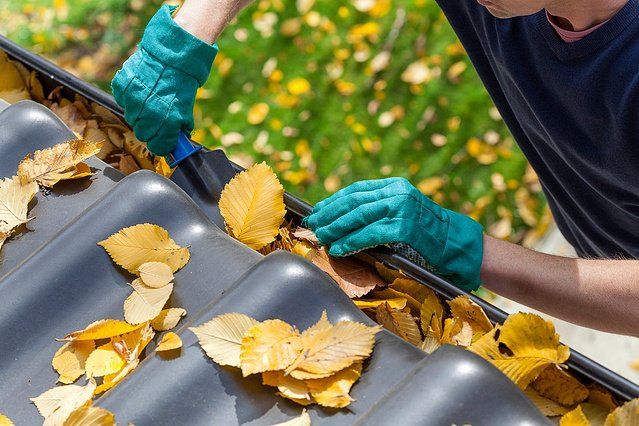
Water-Resistance Is A Necessity
When you're choosing a pair of outdoor work gloves, one of the first things you should consider is whether they're waterproof. It's likely that outdoor workers will run into some kind of moisture, whether that's rain, snow, ice or damp soil - after all, this is Britain.
The best and easiest way to avoid cold, drenched fingers, potential blisters and reduced productivity is to look for waterproof gloves. Avoid water absorbing materials like cotton and opt for leather, PVC or polypropylene. Gloves that have palm coating and wrist cuffs to further repel water are even better.
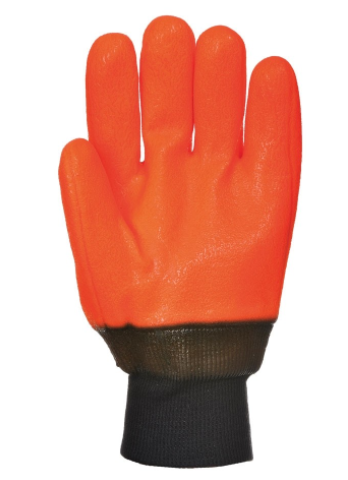
We recommend: Waterproof Hi Vis Glove
Consider What Job The Gloves Will Be Used For
There are many gloves made from varying materials and offering a range of features, which will each be better suited to different jobs and requirements. It will be much easier to narrow down your options if you take into account the type of work the gloves will be used for.
Consider the hazards your workers might face by having a look at your health and safety policy.
If your workers are likely to be scratched or cut on a regular basis, invest in gloves made from heavyweight, durable materials. They might even have long cuffs to protect the arms. Consider the time of the year. For example, insulating gloves are great for the colder months, but not so great for the warmer months.
Remember that outdoor workers are exposed to different hazards to indoor workers such as the weather and their gloves may experience greater wear and tear. For that reason, outdoor work gloves tend to be made of thicker materials than indoor gloves. Thin rubber and plastic gloves won't work here, and will only serve to cause injury and hinder productivity. Look for extra durable, heavyweight materials that offer more protection against cuts, scrapes and tears.
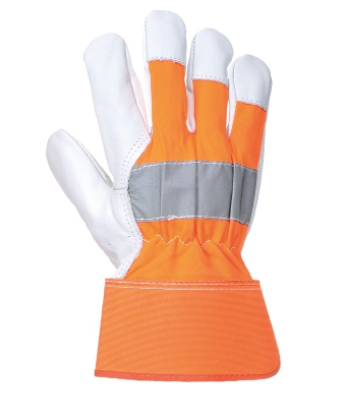
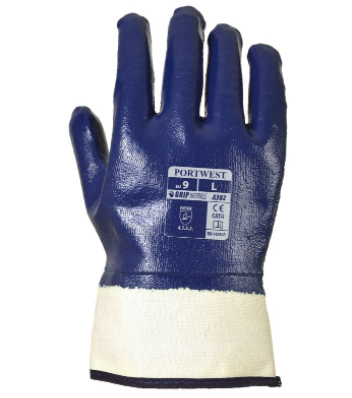
We recommend: High-Vis Rigger Gloves or Fully Dipped Nitrile Safety Cuff
Invest In Gloves With Good Grip And Fit
It's no use having protective gloves made from the thickest, most durable material you can find if they have poor grip or don't fit your employees' hands properly. Look for gloves with rubber dots or criss-crossed material across the palms and fingers for a better grip. Poorly fitting gloves restrict movement and can cause muscle aches, cramps and blisters. Consider these factors when it comes to seams, which can affect comfort and the longevity of the gloves:
Seams on the inside last longer, but tend to chafe the skin Seams on the outside are more comfortable, but tend to wear out more quickly Seams across the palm are usually more comfortable Seams across the back often provide a more exact fit
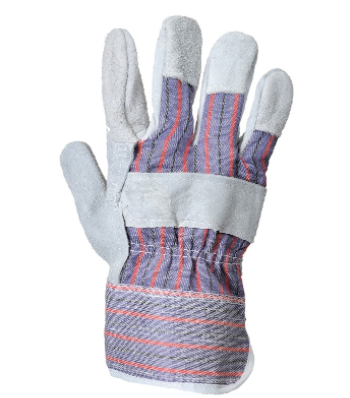
We recommend: Canadian Rigger Glove
Invest In Gloves With Special Features To Further Protect Your Employees' Hands
Although thick, high quality materials and waterproofing are often enough to protect your employees' hands from hazards and anything else they might encounter on the job, additional features, such as insulation and sweat control, can go a long way towards making the job easier.
Many high quality work gloves come with Insulatex lining, velcro wrist tabs and cuffs for improved fit and even be made of materials that help to minimise sweating by allowing the wearer's hands to 'breathe'. All-natural fibres such as wool and synthetic fibres such as polypropylene are great for keeping hands warm yet dry.
We recommend: Lined Driver Glove
Still Wondering About What Your Outdoor Team Should Wear?
It doesn't stop at the perfect pair of outdoor work gloves - there are many other factors to consider when you're putting together a workwear uniform for your outdoor team. Ensure that your employees are fully protected and prepared for their jobs this spring.
Gloves are a useful tool that many people often overlook when putting together an outdoor work uniform. There are many different types and styles made from a variety of different materials to choose from – you’ll be surprised. From man-made materials to real leather and performance styles to models with enhanced grip and insulation, you […]
There are several types of gloves available to purchase for a reason. You should avoid making the mistake of assuming that any type of glove can be used for any type of work you undertake, as this can bring its own set of dangers. That's why gloves are rated into three separate categories and all come under different standards - they all depend on your situation. Here's how to pick glove ratings in line with EN-standards.
There Are 3 Top-Level Categories Of Gloves
- Category One (1) - Minimal Handling Risk
- Category Two (2) - Intermediate Handling Risk
- Category Three (3) - High Level of Risk
Protective gloves can be divided into three categories, depending on the type and which danger or risk the gloves should be protecting against.
Gloves designed for minimal risks are placed in category one. Gloves designed to be suitable for intermediate risks are placed in category two. Gloves that are designed to protect against the highest levels of risk, such as corrosive acids, high heat and [something] are placed in category three.
However, the EN standards can be broken down further.
Before looking in depth at the standards, here's the recommended glove for each respective standard and which kind of roles they're best suited for:
Standard Recommended Glove Ideal For
EN 420 Portwest Canadian Rigger Glove Drivers and Riggers
EN 388 Portwest Cut 5 PU Palm Glove Cut-resistance
EN 407 Portwest Welders Gauntlet Welding and thermal hazards
EN 12477 Portwest Ambi Dex Welding Gauntlet Welding and mechanical hazards
EN 374 Portwest Nitrosafe Chemical Gauntlet Chemical, oil and food industries
EN 511 Portwest Antarctica Insulatex Glove Operating in cold temperatures
EN 10819 Portwest Anti Vibration Glove Dealing with power tools
And here's a breakdown of each standard in more detail...
EN 420 This standard defines the general requirements for protective gloves in terms of construction, fitness of purpose, safety etc. The pH of the gloves should be as close as possible to neutral. The gloves themselves should not impose a risk or cause injury. Gloves must feature specific details This standard is seen as the benchmark of safety - all safety gloves must earn this standard first. Not every glove will have EN 420 as an accolade as it consists of fairly commonsense specifications. Leather gloves should have a pH value between 3.5 - 9.5. Recommended glove: portwest canadian rigger glove
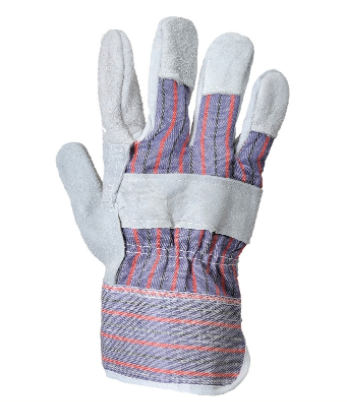
Portwest Canadian Rigger Glove
A popular leather style which features vein protection. The cotton backing increases comfort and ventilation. Ideal for drivers and riggers.
EN 388 These are gloves which provide protection from mechanical risks. Protection against hazards is represented by four numbers, each one representing test performance against specific hazards. 1 - Resistance to abrasion. Based on the number of cycles required to abrade through the gloves. Protection factor is indicated on a scale of 1-4 depending on how many revolutions are required to make a hole in the materials. 2 - Blade cut resistance. Based on the number of cycles required to cut through glove at a constant speed. Protection factor is indicated on a scale of 1-4. 3 - Tear resistance. Based on the amount of force required to tear the sample. Protection factor is then indicated on a scale of 1-4. 4 - Puncture resistance. Based on the amount of force required to pierce the gloves. Protection factor is indicated on a scale of 1-4.

Image Credit: Cut Safe
RECOMMENDED GLOVE: PORTWEST CUT 5 PU Palm glove

Portwest Cut 5 PU Palm Glove
This glove offers maximum protection against cuts and sharp objects. Ideal for workers searching for cut-resistant gloves.
EN 407 Gloves under this standard have been tested under six different tests designed to cover a range of threats. The higher the number in each test, the better the result. This standard is used to determine the level of protection that gloves have against a number of thermal hazards. Test #1 - The resistance to flammability. Test #2 - The resistance to contact heat. Test #3 - The resistance to convective heat. Test #4 - The resistance to radiant heat. Test #5 - The resistance to small splashes of molten metal. Test #6 - The resistance to large splashes of molten metal. RECOMMENDED GLOVE: PORTWEST Welders gauntlet

Portwest Welders Gauntlet
This style is ideal for workers who work in welding or operate under any other thermal hazards.
EN 12477 This standard describes how the gloves are designed to provide protection for both hands and wrists while welding or similar work. This standard is a combination of testing EN 388 and EN 407. Gloves under this standard will provide resistance to small splashes of molten motel, short exposure to convective heat, radiant heat and contact heat along with mechanical risks. Type A refers to gloves which provide higher protection against heat. Type B refers to gloves which provide lower protection against heat, but are more flexible. RECOMMENDED GLOVE: portwest ambi dex welding gauntlet
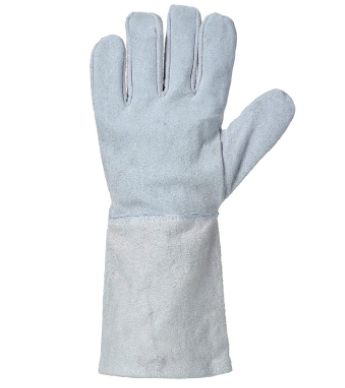
Portwest Ambi Dex Welding Gauntlet
This ambidextrous workers glove offers thermal protection to welders or against any other thermal and mechanical hazards.
EN 374 Gloves under this standard give protection from chemicals and micro-organisms. These gloves are tested and approved chemical gloves to withstand over 15,000 different chemicals and over 60,000 products in various industries. In order to pick the safest glove, you must find out the names of chemicals you will work with and how long you will be in contact with said chemicals. Gloves tested for this standard must be liquid-proof and can't be penetrated when undergoing an air or water leak test. RECOMMENDED GLOVE: PORTWEST nitrosafe chemical gauntlet

Portwest Nitrosafe Chemical Gauntlet
Ideal for workers look for a glove with enhanced grip. Recommended for use in the chemical, oil and food industries.
EN 511 These gloves are designed to provide protection from cold. Two things are measured with the glove: how the glove's material leads cold and the material's insulating capacity. The gloves' pictogram will show either a 0 or a 1. 0 indicates that the gloves suffer from water penetration after 30 minutes while a 1 indicates the gloves suffer from no water penetration after 30 minutes. The higher performance level of the glove, the better the insulating capacity. RECOMMENDED GLOVE: PORTWEST Antarctica Insulatex Glove
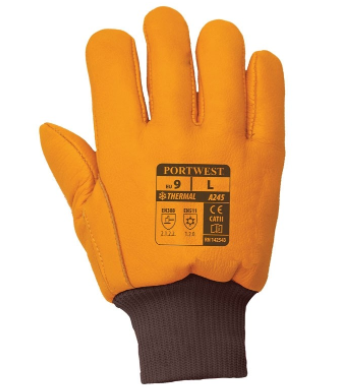
Portwest Antarctica Insulatex Glove
This glove features premium quality cow grain leather with Insulatex lining for enhanced warmth. This is the ideal style for coldstore applications and workers operating in cold temperatures.
EN 10819 Gloves under this standard provide protection from vibration. The standard implies that gloves shouldn't enhance vibrations with a moderately strong frequency (31.5 Hz to 200 Hz). When there's a high frequency (200 Hz to 1250 Hz), the gloves will reduce the levels of vibration by 40%. RECOMMENDED GLOVE: PORTWEST anti vibration glove
Portwest Anti Vibration Glove
This glove is specifically designed to reduce the effects of impact and vibration. Ideal for workers operating with power tools, jackhammers, concrete breakers and more.
By following and understanding the above standards and glove ratings, you're able to put yourself in a much better position when it comes to purchasing gloves that will keep you safe from specific hazards.
There are several types of gloves available to purchase for a reason. You should avoid making the mistake of assuming that any type of glove can be used for any type of work you undertake, as this can bring its own set of dangers. That’s why gloves are rated into three separate categories and all […]
Ignoring PPE maintenance a terrible idea for your business. When safety goes out the window, accidents happen. If accidents happen at work, that means you lose time and money - in the form of worker absence, compensation payouts, and potential fines.
It’s estimated that over 600,000 workers are non-fatally injured at work, often resulting in long absences - but the real figure could be much higher as these accidents often go underreported. Almost 150 workplace fatalities occur each year, but numbers are declining because there are safety measures in place.
Here are some tips on how to perform PPE Maintenance, and how often your company should replace this equipment.
- Page Contents
- Head Protection
- Hearing Protection
- Eye Protection
- Foot Protection
- Hand and Arm Protection
- Respiratory Protection
- Hi Vis Clothing
- Conclusion
Head Protection
Clean
- Clean daily or weekly as needed.
- Clean once a month by soaking in mild soap and hot water for 5-10 minutes and rinse with clean water, wipe, and air dry.
Maintain
- Inspect suspensions before each use.
- Inspect for cracking and gouging (replace immediately if these are found).
- Ultraviolet (UV) exposure, extreme temperatures, chemical exposure, and daily wear can affect the hat’s lifespan.
- Prolonged sunlight exposure can cause flaking and cracking of the shell.
- Chemicals can impact protective measures.
Replace
- Replace hard hats every 5 years (as per manufacturer recommendation).
- Replace internal suspension every 12 months.
- Replace every 2 years if exposed to high temperatures, extreme sunlight, or adverse conditions.
- Replace when cracked or gouged.
- Replace if head protection has sustained impact.
- Replace if head protection is no longer effective.
Hearing Protection
Clean
- To clean hearing protection disassemble ear muffs (not needed for earplugs).
- Wash with mild liquid detergent and rinse in warm water.
- Ensure sound attenuating material inside ear cushions does not get wet.
- Remove skin, oil, and dirt that can harden ear cushions with a soft brush.
- Squeeze excess moisture from ear cushions and place on clean surface to air dry.
- Dispose of disposable earplugs as most cannot be cleaned.
Maintain
- Check hearing protection works effectively, is in good, clean condition, has undamaged seals, headband tension not reduced, has no unofficial modifications, and doesn’t have excess wear and tear.
Replace
- Replace hearing protection when product shows wear and tear.
- Earplugs are no longer pliable.
- Headbands are stretched.
- Ear cushions degraded.
- 6-8 months have passed for normal wear or 3-4 months have passed with heavy use or humid/extreme climates.
- Dispose of disposable ear plugs daily.
Eye Protection
Clean
- Clean daily following manufacturer’s instructions.
- Blow loose dirt and debris from the lenses.
- Rinse under running water (with or without detergent) or use lens cleaning wipes or spray.
- Store in a safe place ( in cases or in any other clean, dry place).
- Avoid rough handling as scratches impair vision and weaken lenses.
Maintain
- Check eye protection for scratches, pits, broken parts, or ill fit.
Replace
- Glasses should be replaced at least every 3 years If Not Used. Every 3 month if used daily.
- Replace damaged, scratched, pitted, broken, bent, or ill-fitting glasses as these do not provide protection.
- Replace damaged parts with original manufacturer parts only to ensure the same safety rating.
Foot Protection
Clean
- Keep clean based on the manufacturing instructions.
- Protect from water damage.
- Wash and dry daily.
- Polish leather footwear and remove debris with a brush.
- Clean soles by brushing and washing air dry - never force dry.
Maintain
- Check footwear for cleanliness, water damage, and debris damage.
Replace
- Replace safety footwear when it’s 6-12 months old, it’s defective, or worn
Hand and Arm Protection
Clean
- Wash/dry (or dispose) of gloves properly.
- Don’t touch contaminated gloves with bare hands.
- Wash hands when taking gloves off.
- Same applies for protective sleeves.
Maintain
- Examine before wear in case of manufacturing defects.
- Extend glove life by washing and rotating gloves.
- Always inspect gloves before use to ensure they are safe.
Replace
- Replace gloves when worn out, torn, heavily soiled, or every day to every three weeks, depending on type of gloves.
- Replace after each use (for disposable gloves) or moving from task to task (either dispose or clean).
Respiratory Protection
Clean
- Clean and sanitise after each use.
Maintain
- Inspect before each use.
- Record inspection dates, finding, and repairs.
- Emergency use respirators need to be checked monthly for tightness of connection, head straps, valves, tubes, cartridges, canisters, filters, rubber, elastic, and moveable parts for signs of deterioration.
Replace
- Replace respiratory equipment as per manufacturers specified replacement rate / replacement filter rate (daily, weekly, after so much exposure).
- Single use respirators must be disposed of after use or when soiled, damaged, or if it becomes difficult to breathe
Hi Vis Clothing
Clean
- Clean your Hi Vis regularly/daily according to manufacturer instructions.
- Cleaning method will vary for different types of clothing.
Maintain
- Maintain hi vis by repair when possible, or replace if not.
- Employers are responsible for replacing as needed, but well maintained hi vis can last months to years depending on exposure and work environment.
Replace
- Replace hi vis when safety is compromised.
- Check for defects (broken, missing, in need of maintenance, burns, spills, excess soiling, tears, deterioration, etc)
Conclusion
Make sure you create a routine part of the work day (or week) where equipment is checked and maintained otherwise safety could be compromised.
Make sure there is someone (or a team of people) responsible for checking PPE maintenance and replacement.
Keep track of what you buy, when it will likely need replacing, and write down when equipment is cleaned and repaired. When equipment is flagged as ‘needs replacing,’ check over the piece of equipment to see if it still performs safely, and if it doesn’t, replace it.
Ignoring PPE maintenance a terrible idea for your business. When safety goes out the window, accidents happen. If accidents happen at work, that means you lose time and money – in the form of worker absence, compensation payouts, and potential fines. It’s estimated that over 600,000 workers are non-fatally injured at work, often resulting in […]
When searching for work gloves, nitrile coated gloves, and latex coated gloves are popular options, but which is best? Before we begin with the merits, let's discuss the properties of latex and nitrile themselves. What is each substance made with, and what's its purpose? Does one fare better than the other? Find out.
The Pure Substances: Nitrile vs. Latex
On a basic level, nitrile is a synthetic rubber whereas latex is a natural material made from actual rubber. When using these gloves in their pure material (think stretchy - usually latex - gloves at the doctor's office) - not the coated kind - it’s important to know if you have an allergy to latex. If you do, then you must use an alternative to latex, but - either way - here are the advantages of pure nitrile gloves vs pure latex gloves.
The advantages of pure nitrile gloves:
They aren’t made with latex (for people with allergies) They are more puncture resistant They have a high sensitivity They mold to your hands They work well against infectious material They are chemical resistant They have a long shelf life For medical grade purposes, nitrile gloves are best if puncture resistance and chemical resistance are of concern.
The advantages of pure latex gloves:
They fit like a second skin They have high sensitivity They are long-wearing They are elastic They are biodegradable They work well for infectious materials They are inexpensive They are naturally chemicall resistant against acids, bases, chlorine, iodine, and formaldehyde. Latex gloves are most popular in the medical industry (as long as they're labeled medical grade), and act as a perfect barrier from bloodborne pathogens as well as other contaminants. They are also food safe, so work well for that industry, and for manufacturing.
However, what about nitrile and latex coated work gloves. Which is best then? Do the properties work the same in coating as they do as a singular product?
Before we get into the answer, it’s important to note that there are four types of palm coating for work gloves: PVC-coated, Polyurethane-coated, Latex-coated, and Nitrile palm-coated. Each have their merits, and which you choose will, ultimately, depend on purpose. Let's get into the uses of each.
The four types of palm-coated work gloves
Before weighing in on which is 'best,' let's take a look at the four types of palm-coated work gloves, and their purposes.
Nitrile-Coated Work Gloves
Nitrile-coated gloves are puncture, cut, snag, abrasion, oil, fuel, and tear resistant - three times more puncture resistant than rubber. Nitrile stands up well to oil unlike rubber. Nitrile isn’t flame resistant, but does well in a range of temperatures: between -4°C (25°F) and 149°C (300°F). Nitrile can be turned into a foam with sponge-like properties, sucking up oil on the surface of an object, and improving grip. It’s a good choice for jobs working with oily parts like in metal stamping.
Portwest Flexo Grip Nitrile Gloves
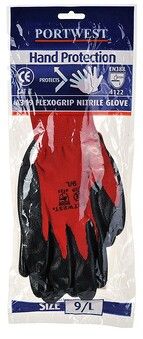
£0.56 per pair
Portwest Green Cut 5
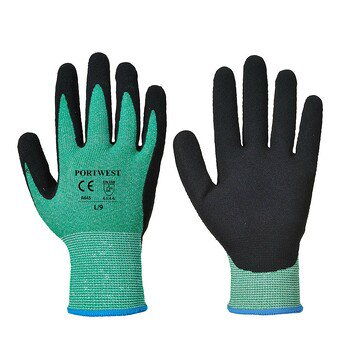
£3.77 per pair
Portwest DermiFlex Ultra +

£1.92 per pair
Portwest Nitrile Knitwrist

£1.13 per pair
Latex-Coated Work Gloves
Latex-coated work gloves, in contrast, have a high elasticity (stretch), and superior grip to any of the other materials. It can withstand high temperatures, and resist tears too. Latex resists alcohols, some ketones, but doesn’t resist hydrocarbon or organic solvents like gasoline. The downside is that many people are allergic to latex.
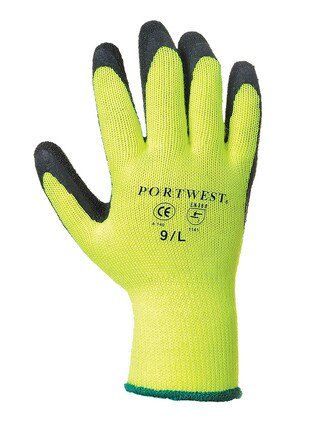
Portwest Thermal Grip Glove £1.57 per pair Portwest Fortis Grip Glove
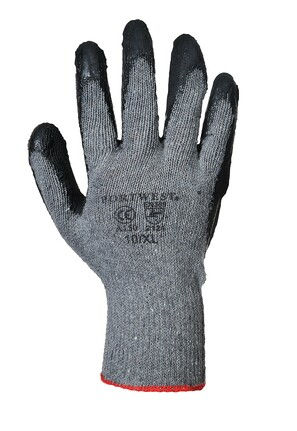
£0.54 per pair
Since our focus is on the two latter options, a quick definition of the other two options is sufficient.
PVC-Coated Work Gloves
A PVC-coated work glove is an inexpensive synthetic material that doesn’t cause allergic reaction. It’s stronger than latex or nitrile. It’s abrasion resistant but susceptible to punctures, cuts, and snags.
It is flexible, but doesn’t provide sensitivity to the touch unlike many rubber products. Its wear and abrasion resistance mirrors nitrile, but the benefit is glue will not adhere to it, so this type of glove is best for glue-related jobs like woodworking, automotive assembly, and trim application. It stays flexible in a lower temperature too, so it’s ideal as a winter glove.
Portwest Weatherproof Hi Vis Glove

£3.25 per pair
Portwest PVC Gauntlet 45cm

£1.75 per pair
Portwest Criss Cross Glove

£0.72 per pair
Portwest Thermolite® Polka Dot Glove
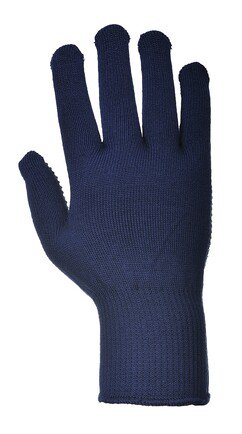
£1.85 per pair
Portwest PVC Knitwrist
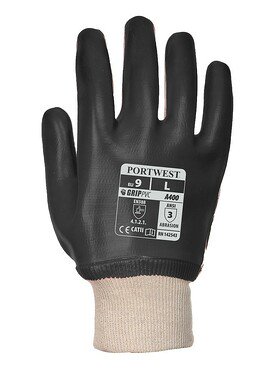
£0.60 per pair
Polyurethane-Coated Work Gloves
Polyurethane-coated work gloves, on the other hand, have great stretch and strength, and have a low particulate shed. This type of glove has recently seen more use in the medical industry on medical equipment for its low-allergic reaction causing properties. This material has a strong, non-sticky grip so it doesn’t need powder to reduce stickiness - like some rubber products. The material is soft with puncture and abrasion resistance, and it’s very versatile overall.
It’s used mostly to provide cut-resistance, and it still allows for sensitivity. It works well for electronic and cleanroom industries. It’s resistant to oil, solvent, fat, grease, gasoline (unlike rubber), oxidation, and ozone, but is not resistant to hot water, and shouldn’t be used above 79°C (175°F).
Portwest PU Palm Glove

£0.35 per pair

Portwest Cut 5 PU Palm Glove
£3.04 per pair
So which should I choose?
Again, what you choose depends on your task and industry; however, for safety purposes, it’s best to find the highest-quality glove you can afford. Buying cheaper alternatives can lead to injury, and higher replacement rate, so whether you’re choosing between nitrile and latex or polyurethane and PVC is really up to you and your industry. For example, if you want to resist high temperatures and have a good grip, latex should be your choice, but if you want to have the best puncture resistance, you’d choose nitrile. For glue-working industries, PVC coating would be the best fit (no pun intended), and for its low shed, cut-resistance, grip, and low allergen properties polyurethane (PU) coating wins. There’s no right answer on what to choose, but your hazard report should provide insight into what will work for your industry.
At Xamax, we have all four of these coatings available in our work gloves with different PPE specifications and price points. Find out which glove is right for you:
Make sure you’re prioritising worker safety.
At Xamax, we aim to keep you safe by providing top quality products at a price that can’t be beaten (talk to our sales team if you find a product cheaper anywhere else - and we’ll match your price). Download your FREE copy of our PPE checklist today so you can find out if you’re PPE compliant. You’ll know when to reorder equipment, how to take care of it, how to store it, how to clean it, and much more.
When searching for work gloves, nitrile coated gloves, and latex coated gloves are popular options, but which is best? Before we begin with the merits, let’s discuss the properties of latex and nitrile themselves. What is each substance made with, and what’s its purpose? Does one fare better than the other? Find out. The Pure […]








